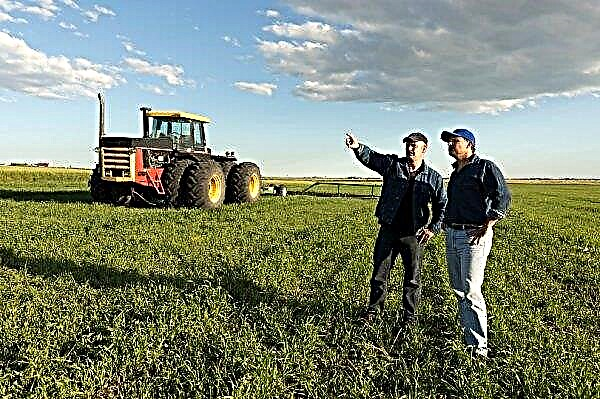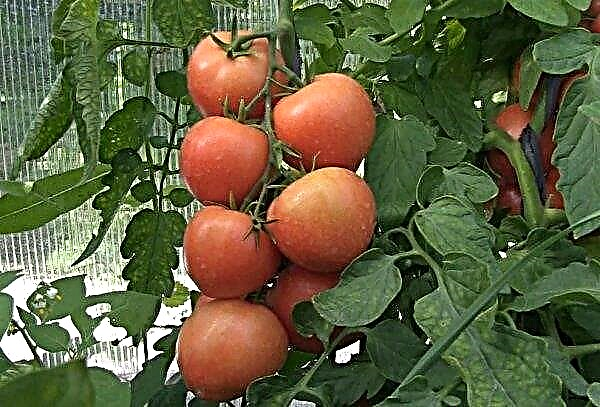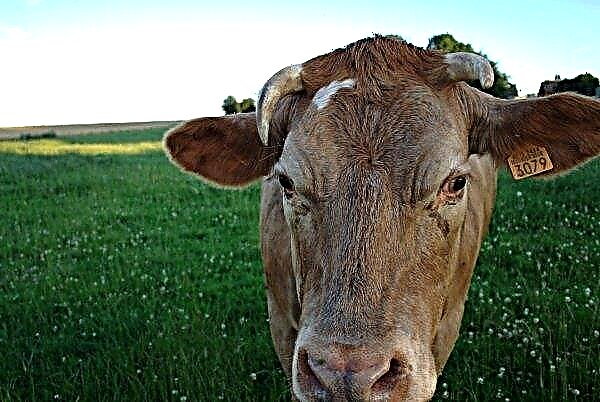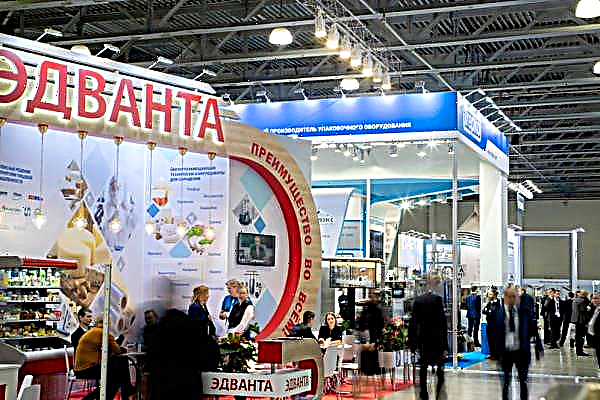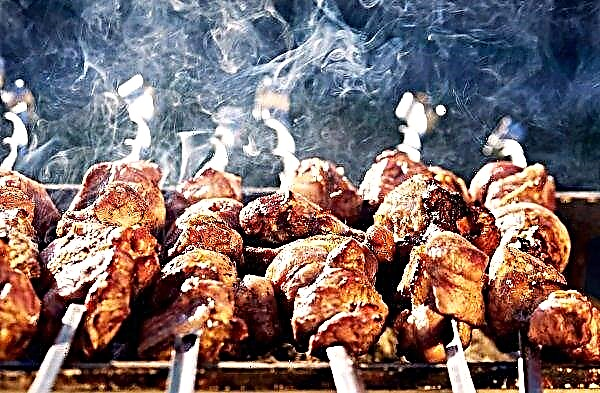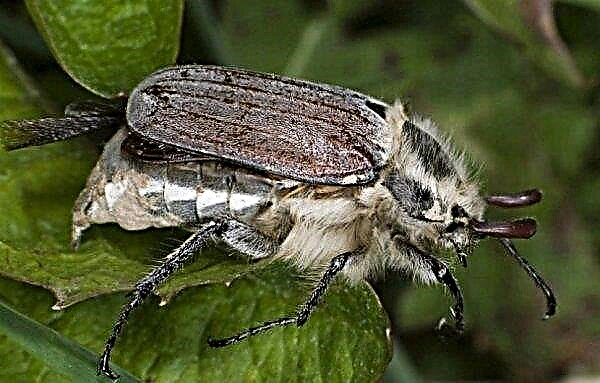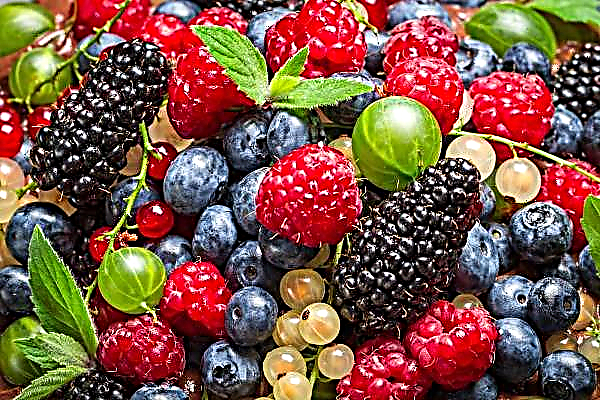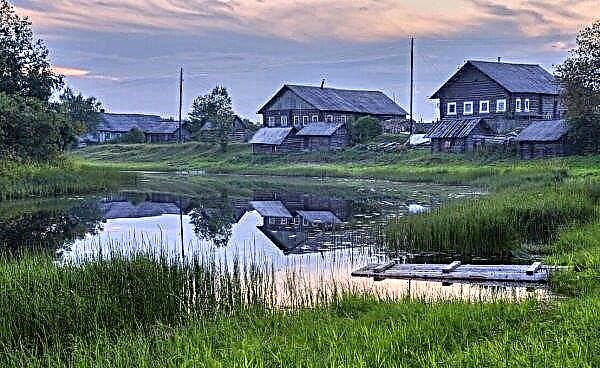In recent years, all kinds of highly productive hybrids of fruit crops have been gaining wide popularity. They are less whimsical to living conditions, and can also please with a crop, regardless of the weather regime. One of these plants is considered to be Jeepsey pepper, which has excellent production and commercial qualities. In this article you can familiarize yourself with the detailed characteristics of the variety, as well as the main subtleties of its successful cultivation.
Variety selection and characterization
Jeepsey Pepper was created in the early 2000s by Dutch breeders at Monsanto Holland. For several years, scientists have been working hard to develop highly productive and unpretentious crop plants, which in a few years made it possible to get a completely new variety. Mass distribution of Jeepsey began relatively recently, in 2007. At this time, the plant appeared on the market in free sale.
Gypsy is intended for cultivation in:
- greenhouses;
- film and polycarbonate shelters;
- tunnels
- open ground.
This variety refers to ultra-early ripening plants that can give the first fruits after 80–90 days after emergence. After planting seedlings in the soil, plants begin to bear fruit within 65 days. The stem of the pepper is medium in size, about 40–55 cm high, elegant and delicate, with a bright green tint. It forms semi-sparse, sparse bushes.Did you know? "Bulgarian" sweet peppers are called exclusively by residents of the former USSR. This is due to the fact that on the territory of Bulgaria there were the largest plantings of vegetables, from where it was transported throughout the entire Soviet Union.
The plant is slightly leafy, leaves on the pepper are formed small, saturated green shade. The leaf blade is rounded, slightly pointed at the edge, slightly wrinkled. The root system of the variety is branched, consisting of numerous thin roots of a dark brown color. During flowering, small axillary flowers develop on the bush, are located singly or collected in small inflorescences-bunches.
After flowering, fruits are formed on the bushes - polyspermous hollow berries with a length of about 11-14 cm and a width of no more than 5 cm. Each fruit is divided into 2-3 segments, their shape is uniform, “Hungarian type”. They are wider at the stalk and thin at the edge, slightly pointed. In the phase of full ripeness, the fruits acquire a rich scarlet hue, while during ripening they have saturated green tones. The average weight of peppers is about 100-150 g.
The yield of the variety is high, under optimal conditions, the plant is capable of producing from 3.5 to 4.5 kg / m² of plantings. Harvest matures amicably and evenly. The fruits of the variety have excellent commercial qualities, they can be stored for a long time, are characterized by increased transportability, as well as versatility. Harvest is ideal for fresh consumption, as well as cooking all kinds of dishes, including for conservation.
Advantages and disadvantages
- The main advantages of the variety, popularizing it among plant growers:
- short growing season;
- unpretentiousness in leaving;
- high resistance to sudden changes in weather conditions;
- excellent fruiting;
- increased aromatic properties of the crop;
- excellent manufacturing qualities;
- universality.
- The plant has a few shortcomings, but still they are. These primarily include:
- medium resistance to specific pests and infections;
- excessively thin stalk, which requires timely garter;
- the degeneration of the variety during the cultivation of seeds of the second generation.
Self-growing seedlings
Among plant growers, pepper is considered a rather whimsical crop. This is associated with a delicate root system, as well as its exactingness for heat. Therefore, plants necessarily create only the most comfortable microclimate.
The timing
The most optimal period for sowing Gipsy seeds is considered to be the end of February or the beginning of March. In this case, around the beginning or middle of May, seedlings will be able to form a complete root system, as well as several leaves. Sowing at another time will lead to the fact that the resulting seedlings will not be able to comfortably adapt to the conditions of open soil.
The soil
Well-fertilized, but light substrates are considered the most suitable for sowing peppers. Such soil should be loose, which allows the roots not only to actively develop, but also to fully receive atmospheric oxygen. For this, the most commonly used purchased substrate for cultivated plants.
You can prepare the soil yourself in several ways, most often a mixture of:
- humus and sod land - 2: 1;
- peat and humus - 1: 1;
- peat, turf land, humus and rotted sawdust - 4: 2: 1: 1.
Regardless of which substrate you use, soil mixtures must be sterilized before sowing. This measure is mandatory, because otherwise the soil can become a source of dangerous infections and pests.Important! To improve the properties of purchased soil, dolomite flour or crushed chalk is added to it (2 tbsp. L / 10 l). This helps to avoid acidification of the substrate, which is detrimental to pepper.
The procedure is carried out in several ways:
- freezing in the freezer for 2-3 days, at a temperature of –20 ...– 25 ° С;
- by frying in the oven, at + 175 ° С, for 25 minutes;
- microwave steaming for 5–10 minutes.
Capacity
For the cultivation of pepper, small individual containers are used, made of plastic wood or other non-toxic materials. Such a vessel must necessarily be no more than 10 cm in diameter, larger pots are not rational, since before transplanting to a permanent place the seedlings will not be able to form a large root system. A prerequisite for such a capacity is a functioning drainage hole, without which the Gypsy sprouts will instantly be covered with putrefactive lesions. Peat tablets are also used for planting, however, in this case, the sprouts often require an intermediate transplant, which is fraught with growth inhibition for them.
The most suitable for seedlings are the so-called individual peat pots. They are small containers made of special agrofibre. This material contributes to the creation of an optimal microclimate, humidity and gas exchange in the soil, which in the end result contributes to a more efficient growth of seedlings. In addition, such pots do not require diving, with further planting, they are placed in the ground with the plant. Under the influence of microflora of the soil, the walls of the pot dissolve and are processed by soil bacteria.
Seed selection and preparation
It is not difficult to choose seeds for cultivating Gypsy; today many shops provide the opportunity to buy high-quality seed that meets all modern requirements. However, when buying seeds, you should carefully consider the packaging. Today, there are many clones of various popular crops, which often do not differ in the excellent quality of the fruits and other important characteristics. Therefore, there is a high probability of acquiring low-quality seeds.
Gipsy seed must meet the following requirements:
- have clearly stated expiration dates;
- beat imported exclusively by Seminis, a subsidiary of Monsanto Holland - the main author and production base of the variety;
- it is imperative to be an F1 hybrid - a plant obtained by direct cross-breeding of mother plants. This is the only condition for a quality crop, as the second generation seeds are unsuitable for sowing.
Before germination, the seeds must be subject to preliminary preparation, which consists of a whole complex of various operations. First of all, they are sterilized, this avoids infection of the sprouts with fungi and other infections. For this, the seeds are soaked for 15–20 minutes in a 2% potassium permanganate solution. Potassium permanganate can be replaced with 70% alcohol, but in this case, soaking should be carried out for no more than 10 minutes.
Next, the seed should be treated with growth stimulants, the procedure helps to improve its germination, seedling friendliness, as well as increase the immunity of future shoots. A variety of drugs are used for this, but the most popular among gardeners are solutions of Zircon (2 drops / 100 ml), Kornevina (1 mg / 100 ml) and Epina (2 drops / 100 ml). Seeds are soaked in working solutions for 4–8 hours, immediately before germination or no later than 2 days before.Important! After sterilization, the seeds must be washed in clean water, otherwise the residual solutions in the future can have a detrimental effect on their germination.
Pepper seeds need preliminary germination, without which their germination is not only sharply reduced, but often excluded altogether. For this, the seed material is kept in warm water for 5 hours at a temperature of +30 ... + 50 ° С. After that, it is wrapped in one layer in a dense gauze or natural cloth moistened with water, and in this state it is kept at a temperature of +23 ... + 26 ° C (as the seeds dry, they are moistened with warm water). After 1-2 days, the seeds will germinate, giving small roots and a germ of the germ.

Sowing seeds
Seeds are sown in small individual vessels, and for efficient growth of Gypsy, a free space of at least 5 × 10 × 5 cm will be required. For sowing, a small depression of 2 × 2 cm is made in the tank. About 2-3 seeds are sown in each hole, after which they neatly wrapped in soil. After the emergence of sprouts, excess plants are removed, this measure helps to prevent low germination of crops, as well as to avoid the irrational use of garden containers. Sown containers are covered with cling film, this is necessary in order to create greenhouse conditions above the soil that safely affect the temperature regime and seed germination.
Seedling Care
Sown containers are transferred to a well-lit place at a temperature of +13 ... + 16 ° С. Within a week, the seeds give the first seedlings, after which the previously installed shelter from polyethylene is removed. In the future, peppers are grown at a temperature of no more than + 18 ° C, this is due to the fact that the stem is characterized by an excess of heat in combination with a lack of lighting. This leads to its fragility, which complicates not only the further transplanting of seedlings, but also the care.
In addition, at low temperatures there is an increased increase in the root system, which is important for further development in open soil. A few weeks after seedlings, the air temperature is increased, while the average daily rate must necessarily be within + 20 ° C.
Pepper loves good lighting and plenty of sunlight. To do this, it is grown on the southern, southwestern window sills. In case of prolonged exposure to direct sunlight, seedlings are slightly shaded. Seedlings are watered as necessary, but not more than 1 time per week, while it is imperative to ensure that water does not accumulate in containers, as this can lead to root rot over time. Use clean, well-defended water at room temperature for irrigation.The first top dressing of seedlings is carried out in a phase of 2–4 of these leaves, using a complex mixture of nitrogen and phosphorus compounds for this. For this, 5 g of urea and 30 g of superphosphate are taken per 10 liters of water. The resulting liquid is used for watering the soil. The second top dressing is carried out 3-4 weeks before the seedlings are planted in open soil, for this a mixture consisting of 50 g of superphosphate and 25 g of potassium nitrate (per 10 l of water) is used.
If you grow seedlings in common containers, plants will definitely need to dive in a separate pot. The procedure is often carried out in the phase of 3-4 leaves, when the sprouts form a complete root system. If you grow peppers in individual pots, they pick them once, to move the plants into open soil. The most suitable period for this is considered the end of May, when stable warm weather is formed with an average daily temperature minimum of about + 18 ° С.

Seedling hardening
Hardening is not a mandatory measure, but this procedure best helps prepare young plants for a changing environment. Peppers are often hardened 10-15 days before the expected date of planting in open soil. To do this, they are gradually accustomed to low temperatures within +13 ... + 15 ° С, for this purpose flowerpots are transferred to an unheated balcony, a loggia or a corridor. The first time the procedure is carried out no more than 1 hour, then gradually the periods of stay in the cold are adjusted to 10-12 hours a day. About 3 days before planting, the plants are completely transferred to the street, after which they become almost invulnerable.
Did you know? In the Russian Empire, sweet peppers were grown for a long time as an ornamental plant. This was due to the fact that the then hybrids were not able to grow and bear fruit in temperate and northern climatic zones.
Transplanting seedlings to a permanent place
Peppers are quite tender plants, so they are transplanted into the open soil after they fully form a strong root system. At the same time, the procedure for planting the plants should be approached no less carefully, since it should not only choose the right place and prepare the soil, but also take into account all the features of crop rotation, without which the crop will not exceed average values.
The timing
The most suitable period for planting pepper is the end of May and the first half of June. During this period, a stable thaw is formed with an average daily optimum of + 18 ° C. At the same time, the soil should also warm up well, at least up to + 15 ° С. This is one of the most important requirements, since neglect of it can provoke freezing of the root system of seedlings, and with it its death. By this time, seedlings should reach the age of about 90-100 days after sowing. The stem height of 20–30 cm and the appearance of 6–8 true leaves on it are often evidence of this.
Seat selection and crop rotation
The Gypsy variety is able to bear fruit in almost any conditions, including on poor substrates, however, high crop yields can be achieved only on a correctly and carefully selected site.
An ideal place to land should meet the following requirements:
- it should not be in the zone of constant winds;
- to be well lit, away from any tall vegetation;
- be in the south side, on a plain or a small hill;
- characterized by a groundwater level of not less than 1 meter.
To do this, use the following rules:
- loamy soils diluted with peat;
- clay soils lighten with sand;
- for planting in the area of peat bogs, loamy substrates or soddy soil are introduced;
- sandy soil is diluted with a mixture of peat and clay (2: 1) or turf soil.
 On the site, it is also worth taking care of observing the basic rules of crop rotation.Otherwise, the plantings will not only give a poor-quality crop, but can also be affected by all kinds of specific pests and diseases of the crop. Good predecessors of pepper are: onions, cucumbers, zucchini, carrots, pumpkin, cabbage, legumes, including siderate herbs.
On the site, it is also worth taking care of observing the basic rules of crop rotation.Otherwise, the plantings will not only give a poor-quality crop, but can also be affected by all kinds of specific pests and diseases of the crop. Good predecessors of pepper are: onions, cucumbers, zucchini, carrots, pumpkin, cabbage, legumes, including siderate herbs.To achieve the optimal system of crop rotation, the so-called small, three-year crop rotation is used:
- after pepper, cucumbers, zucchini, onions, carrots, cabbage are planted. After that, in winter, the plot is sown with green manure, which is then mowed and plowed into the soil;
- in the second year, legumes or cruciferous plants are grown on the site;
- in the third year, pepper planting is repeated.
Important! Peppers are forbidden to plant after other solanaceous (potatoes, tomatoes, eggplant, physalis), they are the worst predecessors of the culture.
Gipsy is getting along, as well as other representatives of the culture, not with all the plants on the site. First of all, it is worth making sure that the plantings are away from shrubs, fruit trees and other tall vegetation that can shade beds. Also, peppers should not be grown next to potatoes and beets, as their secretions can cause pepper intoxication. You should not grow nearby and different varieties of pepper, this can cause cross-pollination.
The best neighbors of pepper in the garden are considered:
- eggplant;
- beans;
- a tomato;
- bow;
- garlic;
- corn;
- a variety of spicy herbs.
- dandelion - secretes substances that accelerate the ripening of fruits;
- nettle - saturates the soil with nitrogen, which improves the photosynthetic activity of Gypsy;
- marigolds, nasturtium, petunia, calendula - secrete specific compounds that repel insect pests.
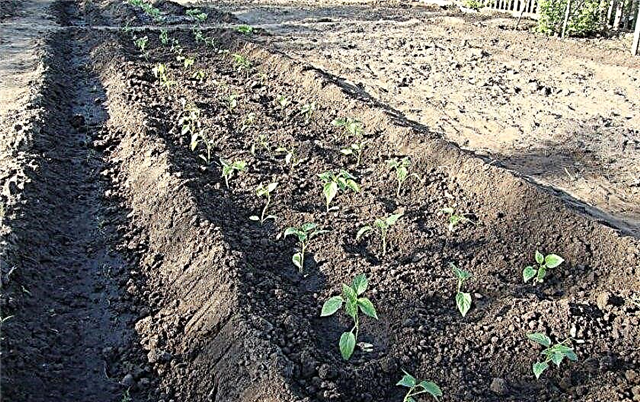
Scheme and depth of landing
The generally accepted scheme for planting peppers involves planting the crop in a row-like manner; for this, rows of about 1 m wide are made with a row spacing of 50–40 cm. When using the row planting scheme, the crop is planted in 2 rows, with a row spacing of 60 cm.
Also, many gardeners use a checkerboard landing, while it is customary to create separate holes 30 × 30 cm or 30 × 50 cm. In this case, plants can create not only individual conditions, but also save the space of the site. In this case, it is imperative to use the basic rule of rational planting of Jeepsi pepper - no more than 5 plants should be on 1 m². The depth of the root system, regardless of the scheme, should be about 10 cm.

Cultivation agricultural
Jeepsey pepper requires standard agricultural practices and techniques for successful maintenance and quality fruiting. Plantings necessarily require daily attention, as well as timely watering, fertilizing and soil care. In this case, it is imperative to use not only generally accepted norms of the procedures, but also the individual needs of the variety.
Watering
Sweet pepper does not like drought, a lack of moisture can lead to prolonged rooting of seedlings, and during flowering, cause the death of most of the ovary. For this purpose, systematic hydration is created on the site, in hot weather, the plants are watered 2 times, in a cool procedure, reduced to 1 watering. A clear sign of the need for plantations for additional moisture is a small dry crust on the soil, about 2-4 cm thick.
To moisten the planting, drip irrigation is used, early morning or late evening is considered the best time for watering. In case of intense solar radiation, it is not recommended to carry out the procedure, as this can lead to instant evaporation of moisture, as well as burns to foliage. Use for irrigation only clean, settled water, heated to ambient temperature.Did you know? By its effect on the body, bell pepper is similar to chocolate. The vegetable provokes a powerful release of endorphins into the bloodstream, which improves mood and helps to overcome daily stresses.

Soil care
Weeding and loosening of soil on the site is carried out regularly. Weeds are removed as necessary, but at least 1 time per week, loosening is often combined with weeding, while additionally loosening the soil the next day after heavy irrigation or heavy rains. Care for the soil carefully, since most of the roots of pepper are in the upper layers of the soil, so garden tools should not go deeper than 4 cm.
If possible, plants are mulched, this measure is not necessary, but it helps to preserve valuable moisture in the soil, to avoid frostbite and drying of the root system, and also to create optimal microflora in the soil. Mulching is carried out at least 2 times, a few days after planting and during flowering. As mulch, wood bark, sawdust, pine needles and other natural materials are used. It is important that the mulch does not touch the most tender part of the bush - the root zone of the stem.
Fertilizer application
Fertilizers are regularly applied under pepper, this culture is considered one of the most demanding nutrients, especially during the period of active fruit formation.
Therefore, in order to avoid a deficiency of nutrients, beds are fertilized according to the following scheme:
- 3 weeks after transplanting the seedlings, the soil is watered with a complex phosphate-nitrogen solution; for this, 25 g of superphosphate and 10 g of urea are dissolved in 10 l of water;
- during flowering, an aqueous solution of 500 g of sugar and 20 g of boronic acid (per 10 l of water) is added to the plot;
- before budding, the soil is poured with a solution of 10 l of water, 10 g of sodium nitrate and 5 g of ammonium sulfate;
- during the filling phase, the beds are fertilized 2 times with nitroammophos (10 g / 10 l of water) and a mixture of 40 g of superphosphate and 20 g of potassium nitrate (per 10 l of water).
Important! Peppers should not be fed with manure. This leads to a sharp increase in the soil of freely available nitrogen, which causes an increase in the aboveground mass of bushes, and this inhibits the filling of the fruit and flowering.
Bushes garter
Garter bushes - this is one of the mandatory procedures that accompanies each grower when growing a variety of Gypsy. Without this, the stem can break off during the fruit filling phase under the weight of the crop near the bush, which almost always threatens the pepper with death. In addition, this kind of sweet pepper differs from nature by a sophisticated stem, which can lead to its breaking off even before the appearance of the ovary.
To avoid this, the garter is carried out as soon as possible, immediately after planting or after 1-2 weeks. As a support, use any load-resistant material (wooden pegs, metal rods, etc.), install a support 5 cm from the trunk. For garter use a dense twine, with which the stalk is wrapped around the center of the bush. In this case, the plant must remain in its natural position and not be subjected to excessive mechanical stress. As the bush grows, the garter is updated, so that the zone of fastening of the bush to the support is in the middle of the stem or slightly higher.
Gypsy is a fairly young, high-yielding variety of table pepper, which is characterized by high productivity, unpretentiousness, as well as increased commercial quality of its fruits. That is why this plant can be successfully grown, both for home use and for sale. This variety is undemanding to care, however, in order to get the maximum possible yield, plantings must be surrounded with daily attention and provide them with optimal water regime, as well as regular feeding.
Network user reviews
ADVANTAGES:
Early, delicious, beautiful
LIMITATIONS:
Weak, slightly leafy plants
I’m a conservative in my life, and therefore introducing new varieties and hybrids on my fields and recommending to my clients the work, although mandatory, but the most unloving. The originator firm and a huge army of “already tried” or “heard” strongly recommended me some new product - an early hybrid of pepper sweet Gipsy. As luck would have it, the early hybrid at that time was of interest to me. What results of our acquaintance with him can I share? This is undoubtedly a very early pepper. We took the first crop 63 days after transplanting. The quality of the products received, too, without effort, receives well-deserved attention. I have grown beautiful elongated fruits of this Hungarian type. Taste qualities, from such a lover of this vegetable as me, received a lot of praise. We cultivated it in the open ground, although we placed a couple of dozen in a greenhouse (glass). The result in the conditions of the closed ground was also obtained good. What saddened me was some kind of underdeveloped and skinny plant. I understand that if I were far from optimizing the background of nutrition, but I seem to understand agricultural chemistry. Trace elements are provided with plants, I never get carried away with nitrogen. The basic ability of plants is 45-55cm in height, and without soil overload with nitrogen-containing fertilizers, I got up to 65cm. At the same time, the leaves are pale, also somewhat elongated. The exciting moment of the onset of the flowering period, for which it is so complicated, full of many surprises, but at the same time an interesting process of growing plants, took place without any significant hitches. Most consumers choose pepper with rather thick walled and preferably disease resistant. Especially viral diseases were not massively observed, therefore I can recommend this hybrid.


